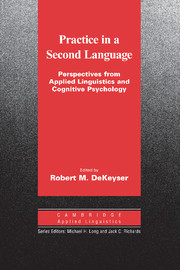Book contents
- Frontmatter
- Contents
- List of contributors
- Series editors' preface
- Introduction: Situating the concept of practice
- I: FOUNDATIONS
- II: INSTITUTIONAL CONTEXTS
- III: INDIVIDUAL DIFFERENCES
- Chapter 9 Age-related differences and second language learning practice
- Chapter 10 Aptitudes, abilities, contexts, and practice
- Conclusion: The future of practice
- Glossary
- Index
- References
Chapter 10 - Aptitudes, abilities, contexts, and practice
Published online by Cambridge University Press: 27 January 2010
- Frontmatter
- Contents
- List of contributors
- Series editors' preface
- Introduction: Situating the concept of practice
- I: FOUNDATIONS
- II: INSTITUTIONAL CONTEXTS
- III: INDIVIDUAL DIFFERENCES
- Chapter 9 Age-related differences and second language learning practice
- Chapter 10 Aptitudes, abilities, contexts, and practice
- Conclusion: The future of practice
- Glossary
- Index
- References
Summary
Introduction: aptitude – the once and future concept
This chapter is concerned with second language (L2) learning aptitude and the cognitive demands of practice in various instructional contexts. Specifically, it describes recent theories of and research into the structure of cognitive abilities that underlie aptitude. It also describes findings from recent empirical research into the extent to which these abilities are drawn on during practice in performing types of pedagogic tasks, in processing L2 input under conditions of practice that manipulate the focus of attention and intention and in uptake of focus on form delivered during practice on these tasks and under these conditions. Broadly conceived, aptitude for learning from opportunities for practice draws on more than cognitive abilities and involves affective and conative factors which may also be consistent determinants of an individual's engagement with the L2 (Ackerman, 2003; Dörnyei, 2002, 2005; MacIntyre, 2002; Robinson, 2005a; Snow & Farr, 1987). This said, this chapter addresses in detail only cognitive aspects of what Richard Snow (1994) called the cognitive-affective-conative triad of factors contributing to aptitude – focusing on these and their interaction with learning contexts.
Task and situation specificity
Aptitude, Snow argued, “should refer to being equipped to work at a particular kind of task or in a particular kind of situation” (Corno, Cronbach, Kupermintz, Lohman, Mandinach, Porteus, & Talbert, 2002, p. 3). The situation specificity of aptitude was an important aspect of Snow's thinking and that of others (see e.g., Sternberg & Wagner, 1994) and leads to the conclusion, explored in Snow's work (and this chapter), that aptitude is variegated but not so variegated as to be infinite.
- Type
- Chapter
- Information
- Practice in a Second LanguagePerspectives from Applied Linguistics and Cognitive Psychology, pp. 256 - 286Publisher: Cambridge University PressPrint publication year: 2007
References
- 58
- Cited by



